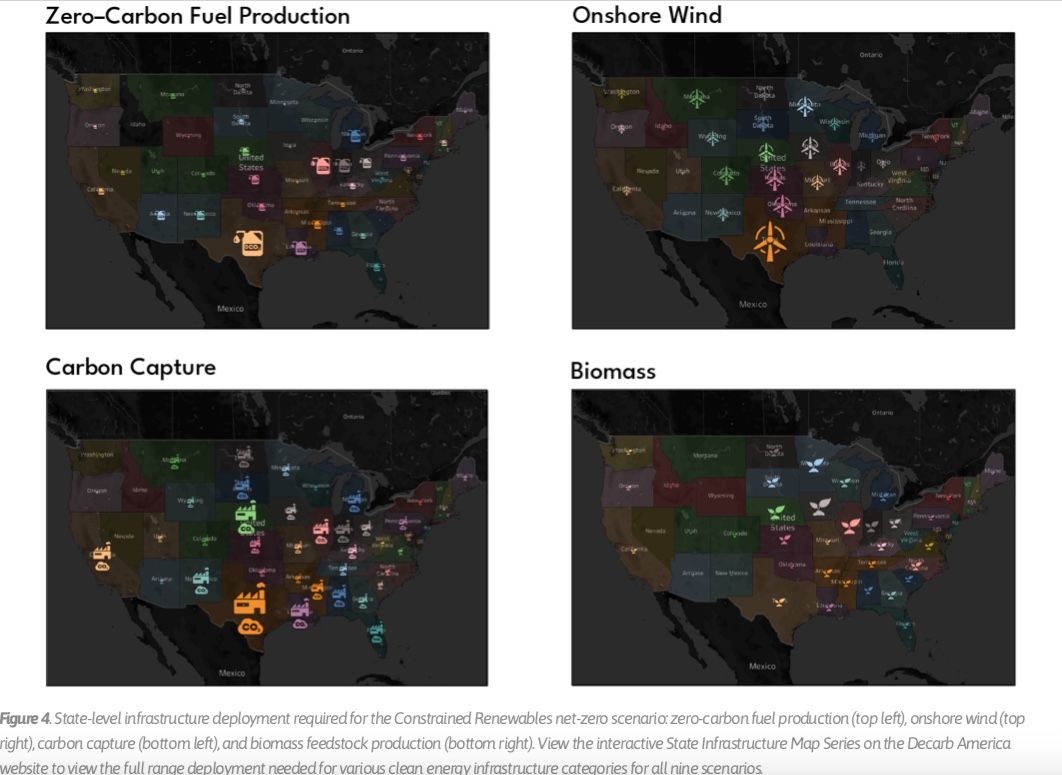Cutting U.S. carbon emissions to zero by midcentury will require trillions of dollars of investment and disrupt entire sectors of the economy reliant on fossil fuels. But that doesn’t mean that states most reliant on fossil fuel extraction or industries powered by them must lose out in the transition.
That’s a key finding of the Decarb America report released Thursday by Third Way, Clean Air Task Force and the Bipartisan Policy Center. It’s the latest in a slew of recent studies projecting the pathways and tradeoffs for reaching the Biden-Harris administration’s goal of a zero-carbon economy by 2050.
Much like a Princeton University-led decarbonization study released in December, the new report uses modeling from Evolved Energy Research to analyze multiple technology and policy pathways to reach this goal. The nine scenarios it models share a common need for a massive build-out of wind and solar power and electrifying transportation and building heating, as do most previous studies.
But the scenarios differ in their assumptions of how quickly renewables will be able to grow and whether consumers will take up electric vehicles and building electrification technologies. That, in turn, guides how much reliance might be placed on alternative decarbonization technologies such as biomass and carbon-neutral biofuels, zero-carbon fuels such as green hydrogen, advanced nuclear power, and carbon capture and storage.
This analysis folded in the expected impacts of existing federal policy proposals from the Biden-Harris administration and in Congress. The goal was to determine “what policies can get us to zero by ’50,” Lindsey Walter, deputy director for nonprofit group Third Way’s Climate and Energy program and a lead author of the report, said in an interview.
In simple terms, the modeling indicates that the most cost-effective path to net-zero will require “a combination of these ambitious performance standards,” such as a clean energy standard, zero-emissions vehicles and low-carbon fuels standards, and carbon and methane capture regulations, “combined with aggressive investments in innovation.”
State-by-state breakdown of clean energy’s growth potential
This approach extends to projecting the infrastructure and investment growth needed to reach the various outcomes called for in the mix of policies being modeled, Walter said. That’s where the state-by-state data comes in.
“We did our own infrastructure downscaling, taking our results and asking, what are the infrastructure needs of our results? What does this do to the energy system needs of the United States?” she said. “That results in maps that show the state-level infrastructure for a zero-carbon economy.”
The research partners have released an interactive map series for the curious to explore these state-by-state energy infrastructure growth patterns in five-year increments over the next three decades. But a simple set of versions below highlights how they work.

In simple terms, “the bigger the icon, the more gigawatts of renewables, or the more sales of EVs,” or the greater investment in zero-carbon fuel production, green hydrogen production and end-use, or carbon capture technologies, she said.
The key takeaway, she said, is that infrastructure and clean energy industry growth isn’t restricted to the set of largely East and West Coast states, such as California and New York, that have taken the most aggressive decarbonization policy actions to date.
“The midcontinental regions play a significant role,” she said. Great swaths of the Midwest have “high-quality wind resources” that could be exported, “and they can co-locate that with the production of hydrogen, which can play a huge role.” Farm belt states can use “abundant agricultural resources as biomass feedstocks,” and industrial Rust Belt states have “the opportunity to build new carbon-capture industries for steel and cement.”
Even the states most reliant on fossil fuel extraction and production today have opportunities for growth in key clean energy industries to make up for losses in those sectors, according to this analysis.
“Texas is the prime example here” of wind and solar power and zero-carbon fuel production replacing oil and gas, Walter said. But while similar replacement opportunities differ from state to state and depend greatly on the particular policy mixes involved, “lots of states that are energy producers today [will] remain energy producers."

It’s unclear whether this analysis will alter political opposition from Republican-Party-dominated states with political leadership most opposed to the decarbonization agenda being pursued by the Biden-Harris administration and Democrats in Congress. The Senate Energy and Natural Resources Committee is set to be chaired by Senator Joe Manchin, the conservative Democrat from the coal-producing state of West Virginia, who has been an outspoken opponent of policies aiming to limit greenhouse gas emissions.
Wyoming Republican Sen. John Barrasso will be the ranking member from the minority party on the key Senate committee; he has spoken out against President Joe Biden’s earliest climate-related executive actions, such as canceling the Keystone XL pipeline and limiting oil and gas leasing on federal lands, characterizing them as taking “a sledgehammer to the economies of Western states without putting a dent in climate change.”
Walter highlighted that Thursday’s report does not take a stance on which of its modeled pathways is the preferred one to reach its target of net-zero carbon by 2050.
“You can look at the tradeoffs in the different scenarios to help inform those different conversations,” she said. “But it’s ultimately up to the policymakers which of these pathways we want to pursue.”




